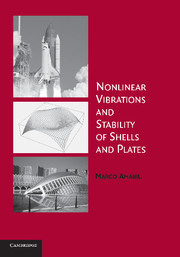Book contents
- Frontmatter
- Contents
- Preface
- Introduction
- 1 Nonlinear Theories of Elasticity of Plates and Shells
- 2 Nonlinear Theories of Doubly Curved Shells for Conventional and Advanced Materials
- 3 Introduction to Nonlinear Dynamics
- 4 Vibrations of Rectangular Plates
- 5 Vibrations of Empty and Fluid-Filled Circular Cylindrical Shells
- 6 Reduced-Order Models: Proper Orthogonal Decomposition and Nonlinear Normal Modes
- 7 Comparison of Different Shell Theories for Nonlinear Vibrations and Stability of Circular Cylindrical Shells
- 8 Effect of Boundary Conditions on Large-Amplitude Vibrations of Circular Cylindrical Shells
- 9 Vibrations of Circular Cylindrical Panels with Different Boundary Conditions
- 10 Nonlinear Vibrations and Stability of Doubly Curved Shallow-Shells: Isotropic and Laminated Materials
- 11 Meshless Discretizatization of Plates and Shells of Complex Shape by Using the R-Functions
- 12 Vibrations of Circular Plates and Rotating Disks
- 13 Nonlinear Stability of Circular Cylindrical Shells under Static and Dynamic Axial Loads
- 14 Nonlinear Stability and Vibration of Circular Shells Conveying Fluid
- 15 Nonlinear Supersonic Flutter of Circular Cylindrical Shells with Imperfections
- Index
- References
14 - Nonlinear Stability and Vibration of Circular Shells Conveying Fluid
Published online by Cambridge University Press: 08 January 2010
- Frontmatter
- Contents
- Preface
- Introduction
- 1 Nonlinear Theories of Elasticity of Plates and Shells
- 2 Nonlinear Theories of Doubly Curved Shells for Conventional and Advanced Materials
- 3 Introduction to Nonlinear Dynamics
- 4 Vibrations of Rectangular Plates
- 5 Vibrations of Empty and Fluid-Filled Circular Cylindrical Shells
- 6 Reduced-Order Models: Proper Orthogonal Decomposition and Nonlinear Normal Modes
- 7 Comparison of Different Shell Theories for Nonlinear Vibrations and Stability of Circular Cylindrical Shells
- 8 Effect of Boundary Conditions on Large-Amplitude Vibrations of Circular Cylindrical Shells
- 9 Vibrations of Circular Cylindrical Panels with Different Boundary Conditions
- 10 Nonlinear Vibrations and Stability of Doubly Curved Shallow-Shells: Isotropic and Laminated Materials
- 11 Meshless Discretizatization of Plates and Shells of Complex Shape by Using the R-Functions
- 12 Vibrations of Circular Plates and Rotating Disks
- 13 Nonlinear Stability of Circular Cylindrical Shells under Static and Dynamic Axial Loads
- 14 Nonlinear Stability and Vibration of Circular Shells Conveying Fluid
- 15 Nonlinear Supersonic Flutter of Circular Cylindrical Shells with Imperfections
- Index
- References
Summary
Introduction
Thin-walled circular cylindrical shell structures containing or immersed in flowing fluid may be found in many engineering and biomechanical systems. There are many applications of great interest in which shells are subjected to incompressible or subsonic flows. For example, thin cylindrical shells are used as thermal shields in nuclear reactors and heat shields in aircraft engines; as shell structures in jet pumps, heat exchangers and storage tanks; as thin-walled piping for aerospace vehicles. Furthermore, in biomechanics, veins, pulmonary passages and urinary systems can be modeled as shells conveying fluid.
Circular cylindrical shells conveying subsonic flow are addressed in this chapter; they lose stability by divergence (which is a static pitchfork bifurcation of the equilibrium, exactly as buckling) when the flow speed reaches a critical value. The divergence is strongly subcritical, becoming supercritical for larger amplitudes. It is very interesting to observe that the system has two or more stable solutions, related to divergence in the first or a combination of the first and second longitudinal modes, much before the pitchfork bifurcation occurs. This means that the shell, if perturbed from the initial configuration, has severe deformations causing failure much before the critical velocity predicted by the linear threshold. In particular, for the case studied in this chapter, the system can diverge for flow velocity three times smaller than the velocity predicted by linear theory, indicating, in this case, the necessity of using a nonlinear shell theory for engineering design.
Information
- Type
- Chapter
- Information
- Nonlinear Vibrations and Stability of Shells and Plates , pp. 338 - 354Publisher: Cambridge University PressPrint publication year: 2008
